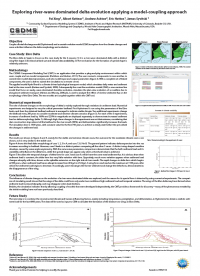CSDMS 2011 annual meeting poster Fei Xing
Exploring river-wave dominated delta evolution applying a model-coupling approach
Albert Kettner, CSDMS - INSTAAR, Univ. of Colorado Boulder Colorado, USA. kettner@colorado.edu
Andrew Ashton, Woods Hole Oceanographic institution Woods Hole Massachusetts, USA. aashton@whoi.edu
Eric Hutton, CSDMS - INSTAAR, Univ. of Colorado Boulder Colorado, USA. eric.hutton@colorado.edu
James Syvitski, CSDMS - INSTAAR, Univ. of Colorado Boulder Colorado, USA. james.syvitski@colorado.edu
Abstract:
Deltas are the important interface between continents and oceans, providing home to over half a billion people. The unique environment supports a wide variety of diverse ecosystems and is highly susceptible to a broad spectrum of interacting forces. Therefore it is critical to understand its current and future changes, especially against the background of climate change and human impact, something that could be explored by studying its historical evolution process. Delta evolution is mainly governed by: a) sediment load supply from its contributing river, and 2) ocean dynamics (e.g. waves, tides). Fluvial sediment supply to a delta fluctuates over time either e.g. due to shifts in climate or, on shorter time scales, due to human interference (e.g. deforestation which could increase sediment supply or the emplacement of dams and reservoirs that reduces the sediment supply). How does this affect the morphology of a delta? Waves interact on deltas by dispersing fluvial sediment, reshaping its shoreline, how will it be illustrated in delta’s shape and morphology?
To study this, we explored hypothetical delta evolution scenarios given the following boundary conditions: a medium size upstream drainage basin (~80,000km2) with, as base case, a typical Mediterranean climate. The analysis is done through coupling two numerical models, HydroTrend and CEM. HydroTrend, a climate-driven hydrological transport model, is applied to replicate freshwater and sediment flux to the delta, and subsequently a coastline evolution model (CEM) is applied to simulate the according changes in the delta’s coastline morphology. A component-modeling tool (CMT) developed by CSDMS, is used to couple the models for this study. Several scenarios are considered that take into account: 1) stepwise increasing fluvial sediment supply, to the delta and 2) the release time of these stepwise sediment increases by changing the storm intensity for periods of time.
Preliminary model experiments will be presented demonstrating: 1) the capability of the CMT to couple models that represent different process domains and were developed and designed independently (i.e. without the intentions of such coupling), 2) the impact of changes in fluvial sediment on deltas.
* Please acknowledge the original contributors when you are using this material. If there are any copyright issues, please let us know and we will respond as soon as possible.

